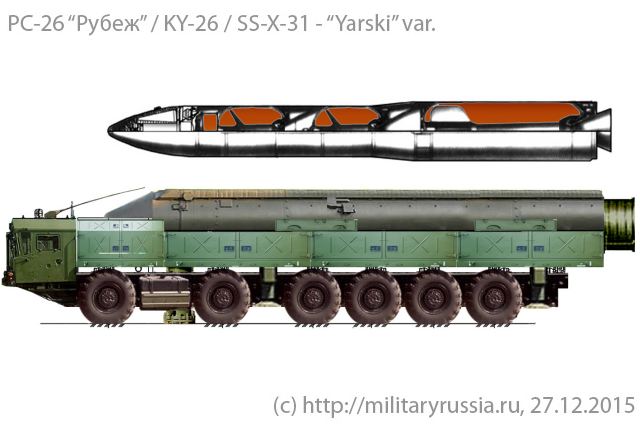Breaking news
Missile forces of Russia will test-fire RS-26 Rubezh ICBM missile second quarter of 2016 12102161.
| 2016
|
|
|||
|
Defence & Security News - Russia
|
|||
|
|
|||
| Missile forces of Russia will test-fire RS-26 Rubezh ICBM missile second quarter of 2016. | |||
|
Missile Forces of Russia will test-fire an RS-26 Rubezh state-of-the-art intercontinental ballistic missile in the second quarter of 2016, a source in the defense industry sector told TASS Saturday, February 20, 2016. The RS-26 Rubezh is an ICBM (Intercontinental Ballistic Missile) based on the RS-24 Yars road-mobile ICBM.
|
|||
|
|
|||
 Futuristic design of the RS-26 based on the RS-24 Yarts ICBM Futuristic design of the RS-26 based on the RS-24 Yarts ICBM |
|||
|
|
|||
|
"The firing is to be conducted in the second quarter of this year from the Kapustin Yar range at the Balkhash range in Kazakhstan," the source said.
The RS-26 solid-propellant ballistic missile codenamed Rubezh is based on the RS-24 missile with an estimated range of 5,800 kilometers (about 3,600 miles).The RS-26 is expected to be lighter than the RS-24 Yars missile and will carry a multiple warhead (the Yars missile is equipped only with one warhead). The RS-26 will be launched only from mobile systems as it has no silo-based version. The missile is expected to come into service with the Irkutsk missile division of Russia’s Strategic Missile Forces in 2016. The first launch test was performed in June 2013, and it was the only launch officially confirmed by the Russian Ministry of Defense. According Russian military sources, Russia's new-generation strategic ballistic missile RS-26 could be put on combat duty as early as in 2016. The confidence test-firing of the RS-26 was carried out in mid-March 2015. According to Western experts, Russia is attempting to fill the gap in its medium-range missile capabilities, which resulted from the 1987 Intermediate-Range Nuclear Forces Treaty (INF) that eliminated ground-launched ballistic and cruise missiles with ranges between 500 kilometers (300 miles) and 5,500 kilometers (3,400 miles). |
|||
|
|
|||
|
© Copyright 2016 TASS. All rights reserved. This material may not be published, broadcast, rewritten or redistributed.
|
|||





























